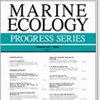High residency of a Critically Endangered hammerhead shark to a small area: implications for marine protected area management and design
IF 2.1
3区 环境科学与生态学
Q2 ECOLOGY
引用次数: 0
Abstract
ABSTRACT: Hammerhead sharks are among the most iconic and threatened shark species. Research has focused on the large hammerhead species, with relatively little work conducted on their smaller-bodied relatives, which face many of the same threats. One such species, the scalloped bonnethead Sphyrna corona, is assessed as Critically Endangered by the IUCN Red List; however, there is no knowledge about its movements, which can compromise management and conservation efforts. Here, we used acoustic telemetry to describe the spatiotemporal movements of scalloped bonnetheads inside a national park’s marine protected area along the Colombian Pacific coast, where this species still occurs in high numbers. The movements of 25 adult sharks were monitored over a 1.4 km2 area for up to ~10 mo between 2022 and 2023. Scalloped bonnetheads exhibited high residency to the area (RImax = 0.78 ± 0.18, RImin = 0.59 ± 0.32, ±SD), with most sharks present during the majority of their monitoring period. Shark movements were influenced by tides and diel period, and the space sharks used was generally small (mean 50% utilization distribution: 0.3 ± 0.2 km2), with most of their movements detected by 2 (out of 5) receivers separated by less than 2 km. These results indicate that scalloped bonnetheads spend a large amount of time in a small area, suggesting that even a spatially limited no-take zone in the National Natural Park is likely to benefit the conservation of this species. This study provides the first insights into the movement behavior of the scalloped bonnethead, with important information for its protection and management.极度濒危双髻鲨在小区域内的高居住率:对海洋保护区管理和设计的影响
ABSTRACT: 双髻鲨是最具标志性的鲨鱼物种之一,也是最受威胁的鲨鱼物种之一。研究主要集中在大型双髻鲨物种上,对其体型较小的近亲的研究相对较少,而这些近亲也面临着许多同样的威胁。其中一个物种--扇贝匙头鲨 Sphyrna corona 被世界自然保护联盟(IUCN)红色名录评定为极度濒危物种;然而,人们对其动向一无所知,这可能会影响管理和保护工作。在这里,我们利用声学遥测技术描述了哥伦比亚太平洋沿岸一个国家公园海洋保护区内扇贝鲣的时空移动情况,该物种在该保护区内仍然大量存在。在 2022 年至 2023 年期间,在 1.4 平方公里的区域内对 25 条成年鲨鱼的活动进行了长达约 10 个月的监测。扇贝鲣在该区域表现出较高的驻留率(RImax = 0.78 ± 0.18,RImin = 0.59 ± 0.32,±SD),大多数鲨鱼在监测期间的大部分时间都在该区域。鲨鱼的活动受到潮汐和昼夜周期的影响,鲨鱼使用的空间一般较小(平均 50% 利用率分布:0.3 ± 0.2 平方公里),大多数鲨鱼的活动都是由相距不到 2 公里的 2 个(5 个中)接收器探测到的。这些结果表明,扇贝鲣在一小块区域内停留了大量时间,这表明即使在国家自然公园内设立一个空间有限的禁渔区,也可能有利于该物种的保护。这项研究首次揭示了扇鳞倭黑头的移动行为,为其保护和管理提供了重要信息。
本文章由计算机程序翻译,如有差异,请以英文原文为准。
求助全文
约1分钟内获得全文
求助全文
来源期刊

Marine Ecology Progress Series
环境科学-海洋学
CiteScore
5.30
自引率
8.00%
发文量
238
审稿时长
3 months
期刊介绍:
The leading journal in its field, MEPS covers all aspects of marine ecology, fundamental and applied. Topics covered include microbiology, botany, zoology, ecosystem research, biological oceanography, ecological aspects of fisheries and aquaculture, pollution, environmental protection, conservation, and resource management.
 求助内容:
求助内容: 应助结果提醒方式:
应助结果提醒方式:


